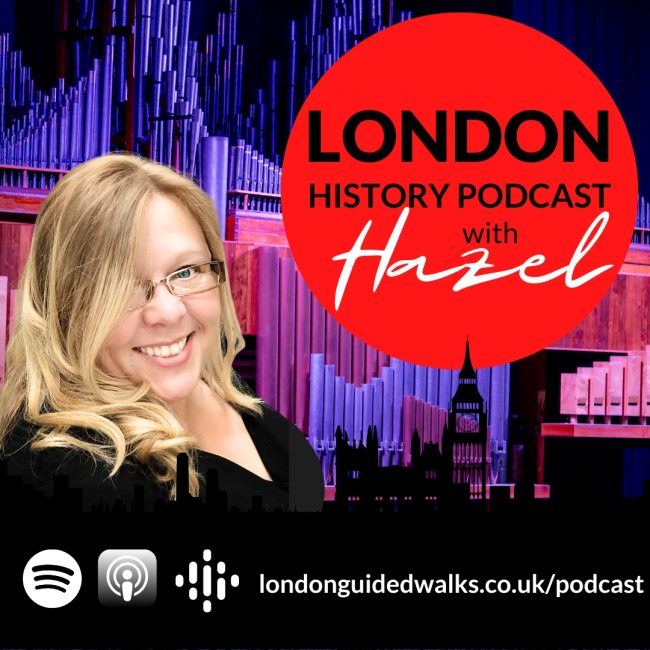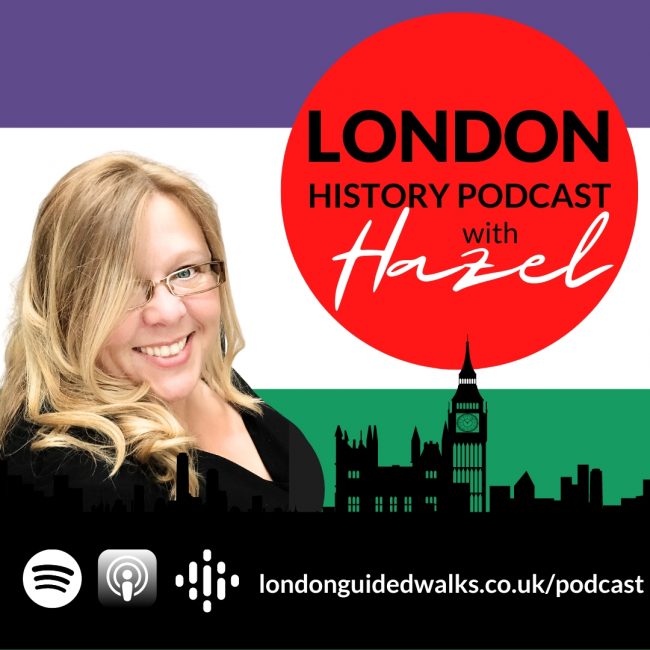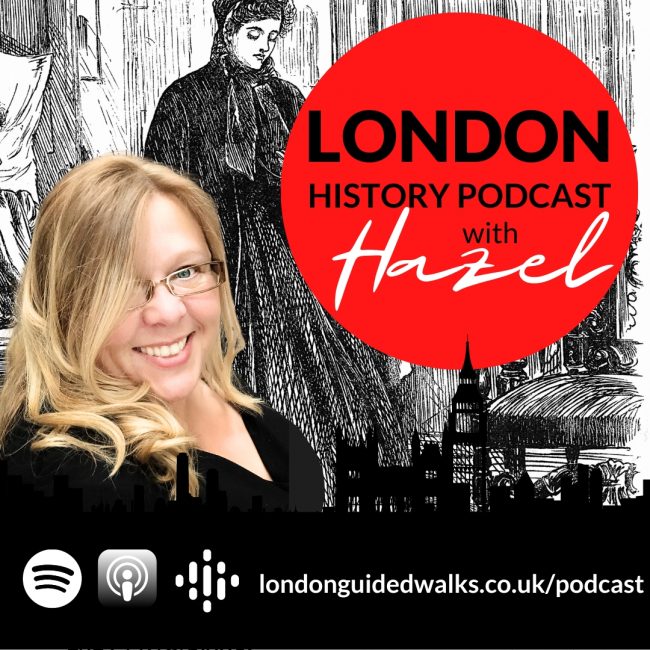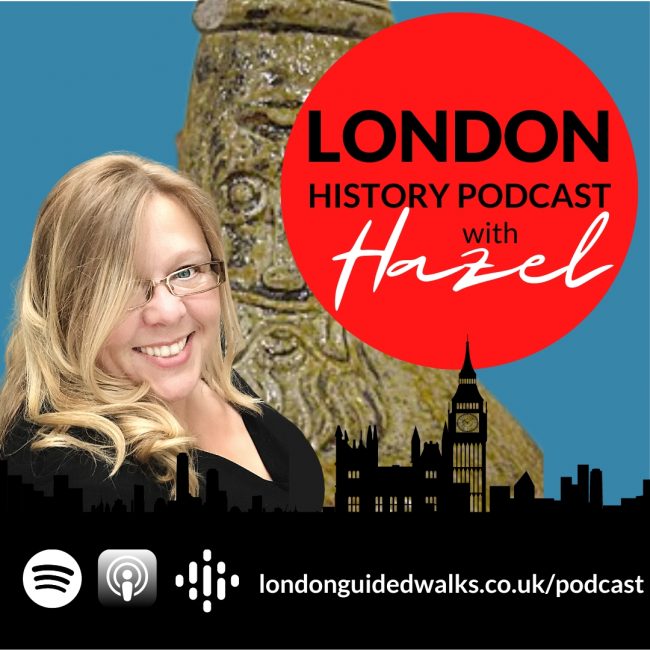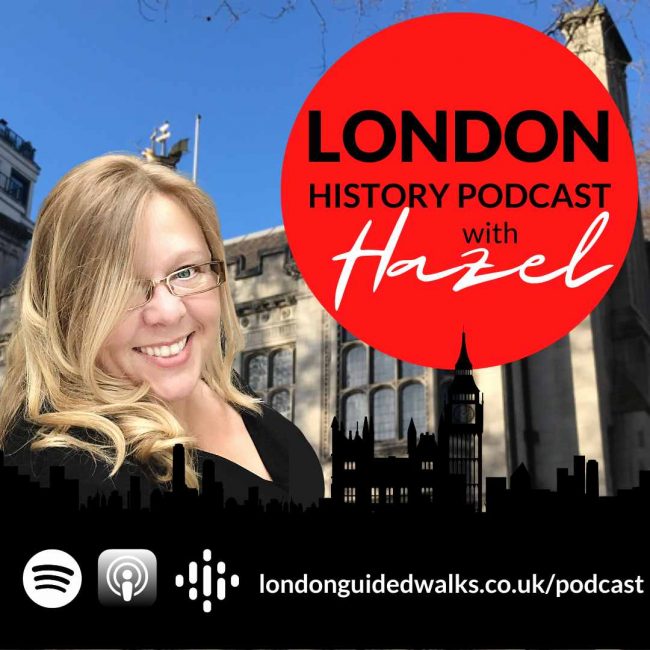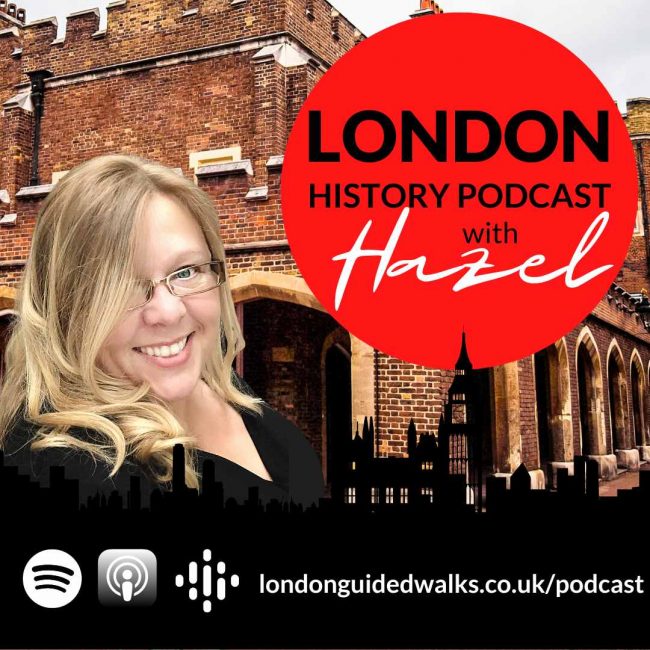Host: Hazel Baker – London Tour Guide


Guest: Dr Gabby Story
Dr Gabby Story is a historian of medieval queenship, gender, and sexuality. Her wider research interests focus on co-rulership, power, and royal studies. She has recently completed a biography of Berengaria of Navarre, queen of England, to be published with Routledge, and has appeared on Channel 4’s Queens That Changed the World as an expert on Eleanor of Aquitaine. For more on her publications and public history work, see www.gabriellestorey.com. Twitter/X: @GabbyStorey Threads | Instagram: @drgabbystorey
Today, we delve into the fascinating life of a woman who was nothing short of a dynamo in the politics, culture, and society of her era—Eleanor of Aquitaine. To situate you in the rich tapestry of London’s history, we must traverse the centuries back to the 12th century, an era teeming with political intrigue, territorial disputes, and colossal figures who left an indelible impact on the course of English history.
Joining me in the study today is Dr Gabby Storey, a historian of medieval queenship, specialising in the twelfth and thirteenth centuries.
So sit back, relax, and prepare to journey through time as we unearth the story of Eleanor of Aquitaine in London.
Eleanor of Aquitaine and London Transcript
[00:00:00] Hazel Baker: Hello, and welcome to our London History Podcast, where we share our love of London. It’s people, places, and history. It’s designed for you to learn things about London that most Londoners don’t even know. I am your host, Hazelbaker Qualified London Tour Guide and c e o and founder of londonguidedwalks.co.uk.
Each episode is supported by show notes, transcripts, photos and further reading, all to be found on our website. Click on londonguidedwalks.co.uk, podcast and then select the episode that you fancy. And if you enjoy what we do, then you’ll love our guided walks and private tours that we offer throughout the year.
So get that cup of tea, put your feet up and enjoy!
Today we delve into the fascinating life of a woman who was nothing short of a dynamo in the politics, culture and society of her era, Eleanor of Aquitaine. To situate you in the rich tapestry of London’s history, we must traverse the centuries back to the 12th century, an era teeming with Political intrigue, territorial disputes, and colossal figures who left an indelible impact on the course of English history.
Joining me in the studio today is Dr. Gabby Storey, a historian of medieval queenship specializing in the 12th and 13th centuries. Sit back, relax, and prepare to journey through time as we unearth the story of Eleanor of Aquitaine in London. Thanks for joining us today, Gabby. It’d be great if we started with an introduction to Eleanor of Aquitaine.
[00:01:52] Dr Gabby Storey: Yeah, absolutely. She is a fascinating woman in her own right. She, as the name suggests, she’s the Duchess of Aquitaine. She was born around 1122 24 to William X, Duke of Aquitaine, and his wife, Aenor of Chatereau. When we’re talking about Aquitaine, we’re really talking about the southwest of France at this point.
The Duchy itself is quite a large area. Now, Eleanor has two other siblings, William and Petronilla. Petronilla is also known as Ilis for some of our listeners who might have come across her before. However, both Williams actually dies earlier than intended, so Eleanor becomes Duchess in her own right in 1137.
Now, Eleanor is 13 to 15 years old at this point. She’s not old enough really to rule in her own right. So she was taken under the guardianship of Louis VI, King of France, and very conveniently then married to his son Louis, the future Louis VII of France. Louis and Eleanor ruled over France together for 15 years from 1137 to 52, and they have quite an eventful partnership in some respects, they go on the second crusade together, their relationship is known to have been a bit tempestuous with one another, and they actually only bear two daughters which for the King of France is not ideal because he wants a son.
So this real difference of personality and the fact that they only have two daughters leads to an annulment, they separate in 1152. And Eleanor then moves quite swiftly onwards to marrying, only eight weeks later after this annulment, to Henry, Duke of Normandy. This is the future Henry II of England and he is the son of Empress Matilda, who might be known to some of our listeners, and Count Geoffrey of Anjou.
Now this union is dynamic. It’s really powerful because it brings together quite a vast swathe of territories across France with various counties on June, Maine, Touraine, Poitou, you’ve got Normandy and Aquitaine, and then the Kingdom of England in 1154. During their time as rulers of England, it was not a peaceful reign by any means.
There is conflict with their neighbouring Dukes and Counts in the Kingdom of France, including the Count of Toulouse, a region to which Eleanor laid claim through her grandmother Philippa. But they’re also very active in terms of children. They have seven children who survive to adulthood. Henry, Geoffrey, Richard, John, Matilda, Leonore and Joanna, which is no small feat for this time period to have so many surviving children.
Plenty of boys. Yes, plenty of boys, plenty of heirs and spares, which does come to bite them on the backside a little bit later, as in spite of all these strong beginnings and the really effective partnership between the two, we do see… Their relationship began to disintegrate around 1168 and a rebellion involving Eleanor and three of their sons against Henry in 1173 /4.
And this marks a real change in Eleanor’s position. She’s been under supervision or captivity for much of the next 15 years. Some of which is in England, so some of that’s around Old Sarum near Salisbury. And… Eleanor is then released by her son Richard in 1189, and comes back to this political scene in full force, acting as a regent and advisor for both her sons Richard and later John Badking, John’s listeners might know him by as well, 1199.
So it’s really only during her final years, bearing in mind she’s 80 at this point in 1202, that she really begins to slow down her political activity. She goes to reside in Fontereau Abbey, Chinon. Where she was involved in politics until her death in 1204. Now, that’s obviously quite a long life that I’ve just given you.
Quite a lot of people and activities and so on. And that’s really reflective of Eleanor’s queenship. Because while she’s queen, she’s very much what we call an itinerant queen. She’s a queen who rules while she’s travelling. This means there are several key cities, like London for example, that are centres of government.
So this is where we can see her kind of pop up all over the place throughout the records. And London’s interesting, as we’ll undoubtedly go on to discuss, because it becomes much more important during the reigns of Henry, Richard and John, because of its developing administrative functions and trade and so on, which I know we’re going to delve onto next.
[00:06:38] Hazel Baker: And this is what’s nice about it, as she said, 80 years, huge, long life packed with activity. So it’s really nice just to really focus on one geographical element. So not necessarily with Aquitaine in London, but also how London perceived her as well. So let’s dive into it then. So we were talking about being one of the most powerful women.
in the 12th century. How did her influence manifest itself in London during her long lifetime?
[00:07:10] Dr Gabby Storey: Eleanor’s position in London, I think we can really clearly see with actually her governance of England with some queens, particularly some later medieval queens, you can see influence through art and architecture, perhaps patronage, but we can see her most clearly because of her governance, particularly during Richard and John’s reigns.
Now she acts as a regent, so she rules on behalf of Richard and John alongside a regency council, but she also works with other figures to ensure stability in England and that taxes are raised for in times of crisis. For example, the ransom that’s raised for Richard after he’s held hostage on his return journey from the third crusade.
She’s present in London for the procession. processions for Richard’s first coronation at Westminster Abbey in September 1189. And coronation, particularly obviously those at Westminster, I mean we know it’s such a fantastic building, this is really something where you are going to see the royals in full force.
And seeing Eleanor taking part in these processions, not just at the Abbey, she’s actually, walking through the streets of London as part of these coronation processions. really emphasizes her status as a female ruler and a queen. And therefore from that, we can also gauge the impact this would have had on the Londoners, the impact this has on her subjects, where we can see, she’s at the forefront of royal political life.
And her importance as her importance as Queen, we can also see with the nobility. So during John’s rebellion against Richard in 1191 2, Eleanor organises a series of meetings with the nobility including one at Temple Church, London, to ensure their support against John and Philip Augustus, the King of France.
So again, By the time we’ve got to Richard and John’s reign, we can see that London is important. London is where we want to have these meetings, where it’s become much more of a political centre during Eleanor’s lifetime, that we’re now starting to move away from Winchester and London is actually where it’s important to have these discussions, to have court, to have these meetings.
[00:09:24] Hazel Baker: It would be good if you were able to really explain the political dynamics that Eleanor was masterful at navigating especially during her time in London. And also how did the interactions of the key figures like Henry and her sons Richard and John how did they affect the City?
[00:09:45] Dr Gabby Storey:
Yes, the relationships between the early Plantagenet kings, so Plantagenet being this dynasty that kind of starts with Henry II and London is interesting because they do rule over such a range of territories that they do have these several key cities that are important and London initially starts as one of many definitely obviously important to England, but doesn’t necessarily hold predominance over some of those other cities.
But London becomes much more important during the reigns of these Plantagenets because it’s transforming as the capital of England, the capital moving from Winchester to London, and therefore you’ve got much more courtly activity and a bit much more wealth. brought into London. Renovations and building projects are undertaken.
We know that Eleanor is a patron of art and literature. She makes religious donations to local institutions. And Eleanor’s partnership with these three kings inevitably has an impact on London itself as well. Her relationship with Henry is very harmonious. to start off with, but it begins to disintegrate as I mentioned there’s this rebellion in 1173.
That rebellion removes Eleanor from the political stage and therefore the eyes of the Londoners. London became used to seeing a king, not necessarily a queen during this period. When Eleanor’s released in 1189, she had such strong relationships with Richard and John. This brings her into greater visibility for the Londoners, they see a queen once again, they see a strong female ruler, and they know that Eleanor is actually going to be an important tie.
for London and the cities on the continent that Eleanor has control over as well. London is going to have greater political and financial status, and this is rarely cemented during Eleanor’s widowhood.
[00:11:45] Hazel Baker: So you mentioned Eleanor being imprisoned for a number of years after her involvement in her, revolt against Henry II.
Do any records or texts exist on how Londoners perceived this or indeed after incarceration?
[00:12:03] Dr Gabby Storey: Unfortunately not for during her incarceration, which is a real shame. She very much falls off the historical record, so to speak, during her imprisonment, it’s a very kind of piecemeal work to try and gather her itinerary and her residences.
Now, there’s a bit of a general silence amongst the chroniclers about her during this period, and therefore how her subjects perceive her, but we do know from what is said that she does actually come back to London. She travels to London with her daughter Matilda in 1184. Now, this is plausibly for a family meeting, maybe even a reunion if we’re going to be nice about it, as we’ve just had Henry the Young King rebel in 1183 and die during that rebellion. So Henry II is now going to be very much aware that the kingdoms are not stable and that they need Eleanor to stabilise political affairs and that has to take place in London. This is now becoming the centre of the kingdom. London is where they need to have these discussions.
[00:13:10] Hazel Baker: And what role did Eleanor play in the Angervin Empire’s administration? And particularly in relation to London, she, and the political and economic hub, there seems to be a lot relying on her.
[00:13:20] Dr Gabby Storey: Yeah, absolutely. Because Eleanor has, really widespread. She’s got a lot of varying roles in the Andrwin Territories because she’s not just Queen of England, she’s Duchess of Aquitaine and Normandy, she’s Countess of all these other territories and she also has a very changeable nature of her partnerships with her husband and sons.
But she has really significant roles. She dispenses legal justice, she grants lands and rents to religious institutions to enable allegiances, and as queen and occasionally regent, she oversees the court in London and therefore is visible to Londoners. She negotiates and networks with the local nobility and the merchants of the city.
So this is where we can really see London and Eleanor together as it developing as an economic hub because the Queen is involved with the revenues of the city. And it’s actually really interesting that it’s during her dowager period, i.e. during the reigns of Richard and John, that we’ve seen much more evidence of her London activities.
And this is because of the movement of administrative systems to London. London is really growing as that kind of economic centre of England as we get towards the end of the 12th century.
[00:14:41] Hazel Baker: And you mentioned about her vast estates in Aquitaine. How did she control them? We’re not talking about it, there are no mobile phones or anything.
We’re talking huge distances and timeframes would be different as well. How did the trade or diplomatic relations between London and regions in France get managed?
[00:15:01] Dr Gabby Storey: Yeah, so Eleanor and Henry are a very itinerant pair of monarchs. They are constantly travelling on progress to try and exercise their authority over all these realms, but even so, they still can’t be everywhere at once.
It’s obviously a big undertaking to travel across the channel at frequent intervals. So they will have administrators, justices and so forth who will work on their behalf. They will have messengers who will help with that dispensing of administration. But because she’s Duchess of Aquitaine, because that’s her homeland, it is somewhere she wants to return to at frequent intervals, and therefore, she has access to vast resources and wealth in the region, she’s got control over these estates, and her position as Queen of England means she can facilitate relationships between merchants and nobles in both areas and even on occasion act as a kind of intermediary between them.
Now, sometimes those roles might actually bring her into conflict because both Londoners and the Aquitanians are quite confident in asserting their own rights, their own taxes, their own revenues, and they are sometimes a bit stubborn with it. In particular, we can think of the trade in Bordeaux wine.
Now, obviously, everyone, when we think about wine, you think about France, don’t you? Absolutely. Wine was just as important in the 13th century as it is now, it really is, the English have a love for wine. of wine from Bordeaux during the 12th century and Eleanor capitalized on this, on Aquitaine’s trading strengths and expanded this to England because London is rarely a suitable recipient of goods such as wine.
[00:16:49] Hazel Baker: Now you mentioned before about with both coronations Eleanor being out there being seen and as a strong female lead. Is there… Any evidence suggests that the Queens, not necessarily just Eleanor, but Queens in this period had an influence on the role of women in London society, either directly or indirectly.
[00:17:12] Dr Gabby Storey: I think with the Queens of England in the 12th and 13th centuries, because they become more visible in some respects. Eleanor is very visible because she has this long life because she has such a marked and remarkable life in a sense. But I think when we think about Queens and their impact on London, it’s going to come across on different levels.
So you can see their encouragement of religious donations, for example, almsgiving, so Queens walking through streets of London donating alms. through their patronage of local institutions, that this is something that would be encouraged amongst the noble ladies of the court as well. So we can see a growth in female religious patronage that can be directly influenced by queens.
We can also see that. There will be a change in purchase and consumerist habits, for example. Queens are often some of the most well-dressed people in the court, so it’s likely that their household ladies are going to be similar, and this is something else you can pick up from in financial records, is how queens spend their money on fashions and on their household and so on, and how this will be replicated through trading records, because what wools, what furs, what fabrics are coming through to London to be apportioned to the noble ladies of the court. So when we’re thinking about how women spend their money, how women act in London.
We can pick that up from financial and trading records. But the other thing I think apart from religious patronage and apart from consumerist habits is actually women’s role when it comes to decision making and power, which is something I do believe that Queens have an impact on because we’ve seen a really interesting and a really important pattern of women who exercise power in this period and therefore.
I think it’s important to note that evidence of a woman being able to make decisions of being able to manage a household, and managing an estate is something that would also be prevalent amongst Londoners. You can have women as heads of households, you can have women acting as merchants, as heads of guilds, as women who can make decisions and authority in their own right, obviously this isn’t completely commonplace, but it is, part of an ongoing trend and ongoing dynamic where we can see women being more and more visible in the records, being more and more active in decision making in their roles, in their positions, no matter what level of society that’s in as well.
[00:20:00] Hazel Baker: How did Eleanor’s experiences in London compare to her time in other Angevin territories like Aquitaine and Poitou?
[00:20:10] Dr Gabby Storey: Yeah, so Eleanor’s experience in her homeland territories of is markedly different to London. Aquitaine is the place she grew up in. It’s the place she returns to as a Duchess.
It’s always got a special place in her heart, that feeling of belonging. And although ruling over her nobles is undoubtedly contentious at times, there’s again, that sense of belonging here. Now, Aquitaine is markedly more sophisticated on a number of levels than London, not to dig London at all, obviously, it is just a, it’s a, I’m very aware, I’m on a London history podcast, but I’m saying there’s a very much difference between the two places at this point, because London, it’s not without, it’s rich, it’s not without its own culture and development, but there’s a real difference between Aquitaine and England in terms of cultural and geographical differences at this point, and I think London might have felt a bit of a shock to Eleanor in comparison because Aquitaine’s had a longer history of investment, of trade, of It of intellectual and literary culture and London just hasn’t had that the same way.
But then if you look at the transformation of London from the 12th to the 16th century, think about what London’s like during the time of Henry VIII, for example, it has really developed that it’s massively a centre of art and learning and so on.
[00:21:39] Hazel Baker: So are you suggesting that Eleanor married down?
[00:21:45] Dr Gabby Storey: Not quite. The kingdom in itself is still absolutely bagsy, isn’t it really? They are the power couple of Europe and I think it’s fair enough to say that Eleanor probably had more of an influence in terms of things that were introduced to England and London than perhaps we might think of otherwise.
[00:22:08] Hazel Baker: Yeah, I think, especially when, I think what’s easier when you’re trying to do something is that you know it’s achievable. So having Eleanor with that experience and knowing how things have worked well, etc. Then that learning benefiting London that, seems to make sense, doesn’t it?
[00:22:27] Dr Gabby Storey: Yeah, absolutely. One of the… Things to think about when we’re talking about, this literary culture, this artistic culture, and so on that Eleanor puts forth. There’s this notion of courtly love, for example, in Troubadour culture that’s been associated with Eleanor. And, although this has been quite exaggerated by some earlier biographies.
biographers of Eleanor. She is certainly a patron of literary culture. In the time of Heron Henry, we see a real boon in historical writing for example, in poetry, and the southern Aquitanian courts are really remarkable in particular for this literary culture. But it’s not quite the same as this idea of courtly love.
They’re constantly surrounded by romantic ideals and there are all sorts of shenanigans going on. It’s not quite that stretch. But we know Henry and Eleanor, they’re both patrons of literature. They both encourage poetry, and artistic culture, including troubadours. And again, as I mentioned, they’ve got this itinerant, this travelling court that spends a lot of time in England.
Some of it’s spent in Winchester, some of it’s spent in London, and as I mentioned, we’re seeing this transformation of the capital and therefore we’re going to see this growth industry culture in London as well because that is where the King and Queen are spending their time. That’s where they’re gonna spend their resources.
That’s where people are going to begin to flock to in order to develop their trades and customs.
[00:23:59] Hazel Baker: 80 years is a long life for even now, let alone back then, and given her extended period and outliving all but two of her children, gosh how did her relationship with London evolve over
[00:24:14] Dr Gabby Storey: time? I think it’s really interesting actually thinking about how her relationship develops, because as I mentioned she’s a travelling queen, but once we’ve got to John’s reign in particular, They have, one, lost territories in France, so there domains have shrunk regardless, which has given them fewer cities to need to be constantly travelling to.
But London has become rarely cemented as a city and as a capital because there are so many administrative functions and systems that have become embedded in London and this means that London’s got more importance and therefore it becomes a place where the court is more regularly settled, where you’re going to have these important meetings with the nobility, with ambassadors and so forth, and where you’ll issue your directives from.
So as a consequence, Ellen spends more and more time in London than before, it’s become the centre of government and you can see this when we’re thinking about Where the expenses go to or where the expenses have come from, London will pop up more and more in these records as we get into the 13th century.
[00:25:22] Hazel Baker: I’m not aware of any, but you might know. Are there any architectural or even artistic artefacts that survive in London that can be directly linked to Eleanor or her
[00:25:35] Dr Gabby Storey: influence at all? Sadly not. I think it’s a real shame as I was doing another piece on Eleanor recently and they were saying oh what images have we got of her and it’s just there’s so little so we’ve got her tomb which is at Fontereau Abbey in Chinon in France and that’s the main kind of artistic site we’ve got for her.
Sheenorn also has the Chapel of St. Radagond and there’s a fantastic mural in there which some have attributed to Eleanor being the primary female figure in the mural. But in terms of London, there’s really nothing that we can directly tie back to her because the only other significant artefact, or artistic piece we’ve got is this rock crystal vase that she gave to her first husband Louis VII upon their marriage, which is also in the Louvre, which is a fantastic gem if anyone ever goes to the Louvre and battles all the queues around the Mona Lisa, you can go and look at this far, but yeah, it’s shocking really that she’s left so little impact on London. And again, when we think about our architectural and artistic legacies, this is something that’s really more dominant a couple of centuries later. Again, think about the amount of. stuff that we have for the Tudors, for instance.
We’ve obviously got Hampton Court Palace and all its goodies and so on, but it’s a real shame you just jump back a couple of centuries and it’s much more difficult to trace their impact.
[00:27:10] Hazel Baker: I suppose a good thing, a lot of it though, with her being the powerful… landowner and political figure, a lot of the things that she did have influence are intangible, they’ve set up processes and how we actually behave. Are there any legal documents or charters in any way in the London archives that shed light on her governance style?
[00:27:32] Dr Gabby Storey: Yeah, absolutely. The legal documents are where we can really see Eleanor’s activity to a point. So Eleanor possesses Dower lands in London. So Dower in Eleanor’s time, the definition does change slightly as we get further on.
So Dower is a property which is allotted to the wife upon marriage for her subsistence during her lifetime. So the type of properties granted and the actual. Properties themselves do vary and some of these properties are in London. So this is an explanation as to why she spends more time in London because she’s going to be overseeing the administration of her lands in this area.
And the records for these lands, her activities are scattered. So we can see evidence of her expenditure. So that can be for her household, for her activities at court, for instance. So Oil and so forth, resources used to support her time. We can find it in the pipe rolls, which are in the National Archives.
There are some grants in what we call the Charter, and the patent rolls, also in the National Archives. And really interestingly, we’ve got a grant of hers to Bermondsey Priory. Which is obviously very local, from her time as Queen Consort of Henry II, which is in the British Library. And that dates from before she was imprisoned in 1173.
So we can see bits of her activity here. We know that she’s got lands here. We know that she’s making donations to local London religious institutions, and that’s still in the London archive. So we can get this idea of her active itinerary and her governance as Queen of England, as well as her role as a religious patron.
as well. So I think it’s, I think the Grant Cabernet Priory is, a really nice little snippet of local history. We can just see all these different institutions she has a connection to. And are
[00:29:32] Hazel Baker: there any medieval chroniclers or historians, contemporary ones that focus specifically on Eleanor’s time that gives us a little bit of a reveal in their writing of who she was or anything like that?
[00:29:47] Dr Gabby Storey: We’ve got a couple of different pieces. So we’ve got the biographer of Thomas Beckett, William Fitzsteven, who describes London during Eleanor’s time, and I think it’s a fantastic description, so I’ll read a little bit of it out. Because he says, It is happy and the healthiness of its. in the Christian religion, in the strength of its defences, and the nature of its sight.
It pours out its fame more widely, sends to fatherland its wealth and trade, its head higher than the rest. And I think that’s a fantastic description of London. William Fitzsteven is a born and bred Londoner. And you can see that pride in his description. He’s really emphasising how wonderful and important it was during the 12th century.
And I think that’s a fantastic little snippet of how he perceived London, what London was like during that period. But in terms of actually Eleanor and London itself, we don’t really have much from the Chronicles, instead, we’re dependent on the financial records to kind of show when she’s in London what her activities are at this point.
But I think we’ve got that little description of London itself and you can, it’s very emotive, isn’t it? It’s very, descriptive and gives us an idea of what it might have been like walking around the streets of London during Eleanor’s time following her footsteps, so to speak. So how does the life of Eleanor of Aquitaine
[00:31:11] Hazel Baker: challenge or maybe confirm the prevailing views of women’s roles and influence during the medieval period? I know we don’t know of many women but specifically in the context of London what have we, what have we learned?
[00:31:24] Dr Gabby Storey:
Ellen is an interesting one because she’s often been viewed as exceptional or a bit of a challenge to our perceptions of medieval women, even as extraordinary for a number of reasons. But she’s very much part of this wider trend or pattern of women who did exercise power, and this is very real, very genuine power in their own right.
Because yes, she’s Queen of England and France, she’s the only woman to have been but her. And her royal power comes from her marriages, but she’s the Duchess of Aquitaine in her own right, and that’s a core part of her power. She’s much more visible to Londoners as Queen of England in these early years of her and Henry’s reign because of their progress She’s regent on several occasions and that centres her further in the eyes of the Londoners as a woman who rules and a woman of power.
As I mentioned, we also then see her in London more and more during Richard and John’s reigns because she’s taking up the reins of government at various points, arranging these meetings, interceding with the nobility and so forth. And I think it would… undoubtedly have an impact on the Londoners because they can see a very strong woman, they can see a woman who can rule.
Again, her longevity really helps her because she’s a constant. We end up going through three kings in about 15 years. When you consider the death of Henry II and then Richard and John, and Eleanor’s still the constant there for all of it. And I think that makes her a reliable studying figure. And in terms of thinking about her influence, obviously, we’ve mentioned her religious patronage, and thinking about women’s roles.
At the end of the day, she is also still a wife and a mother. And I think that’s something that would have touched on the hearts of Londoners as well because you would have had so many obvious families, so many people who were leading their own day-to-day lives. And Eleanor still had that tangible connection to that as well.
She’s still a human being at the end of the day. She might be their queen, but she also goes through all this. familial and political upheaval at points, which is something that Londoners can see as well. They’ve got family disputes. Every family has disputes. You’ve got Eleanor trying to control a wayward son.
There’s undoubtedly a woman in the streets of London who’s thinking, Oh God, my son doesn’t behave himself either. But, I think this is something I think absolutely, Eleanor. Would have been really visible, would have been a person of undoubted interest to the Londoners as their queen, as their ruler.
But as a figure, they actually saw, she’s not hidden away, she’s not a recluse, she’s someone who is. She is in London. She is someone who they can see and I just think she’s fascinating because she has such a busy life. She does pop up all over the place and I think she’s really just an important figure, an important person to explore London through.
[00:34:36] Hazel Baker: Fantastic. I’ve really enjoyed getting to know her a little bit more. 80 years is a long time and as we’ve said, she absolutely packs it in and we’re still only really seeing a glimpse of what she did. So more to discover or not, if the evidence isn’t there. Gabby, thank you so much.
[00:34:56] Dr Gabby Storey: Thank you very much, Hazel. It’s been a blast. Really enjoyed chatting with Eleanor through London’s eyes.
[00:35:02] Hazel Baker: That’s all we’ve got time for. Until next time.




